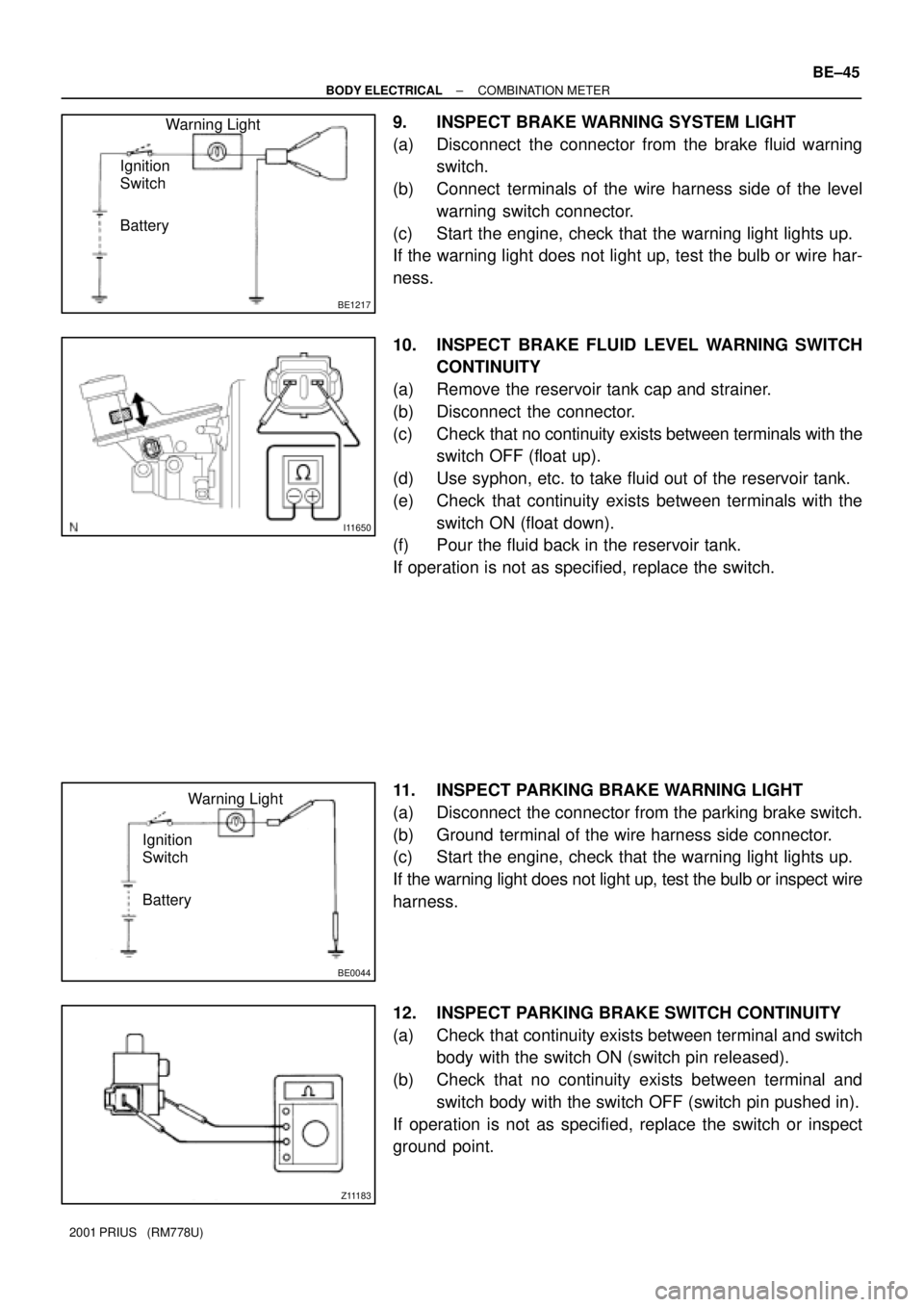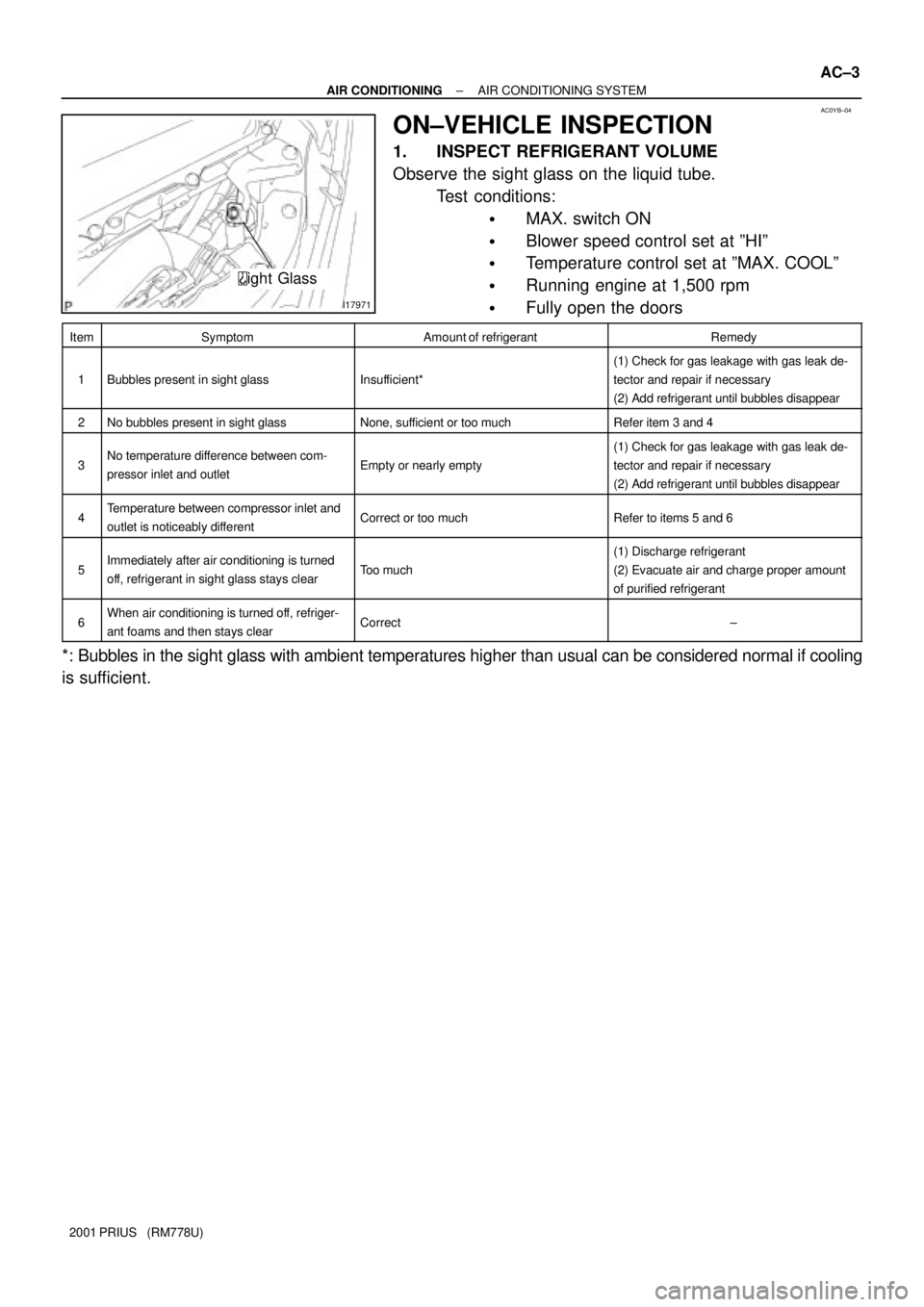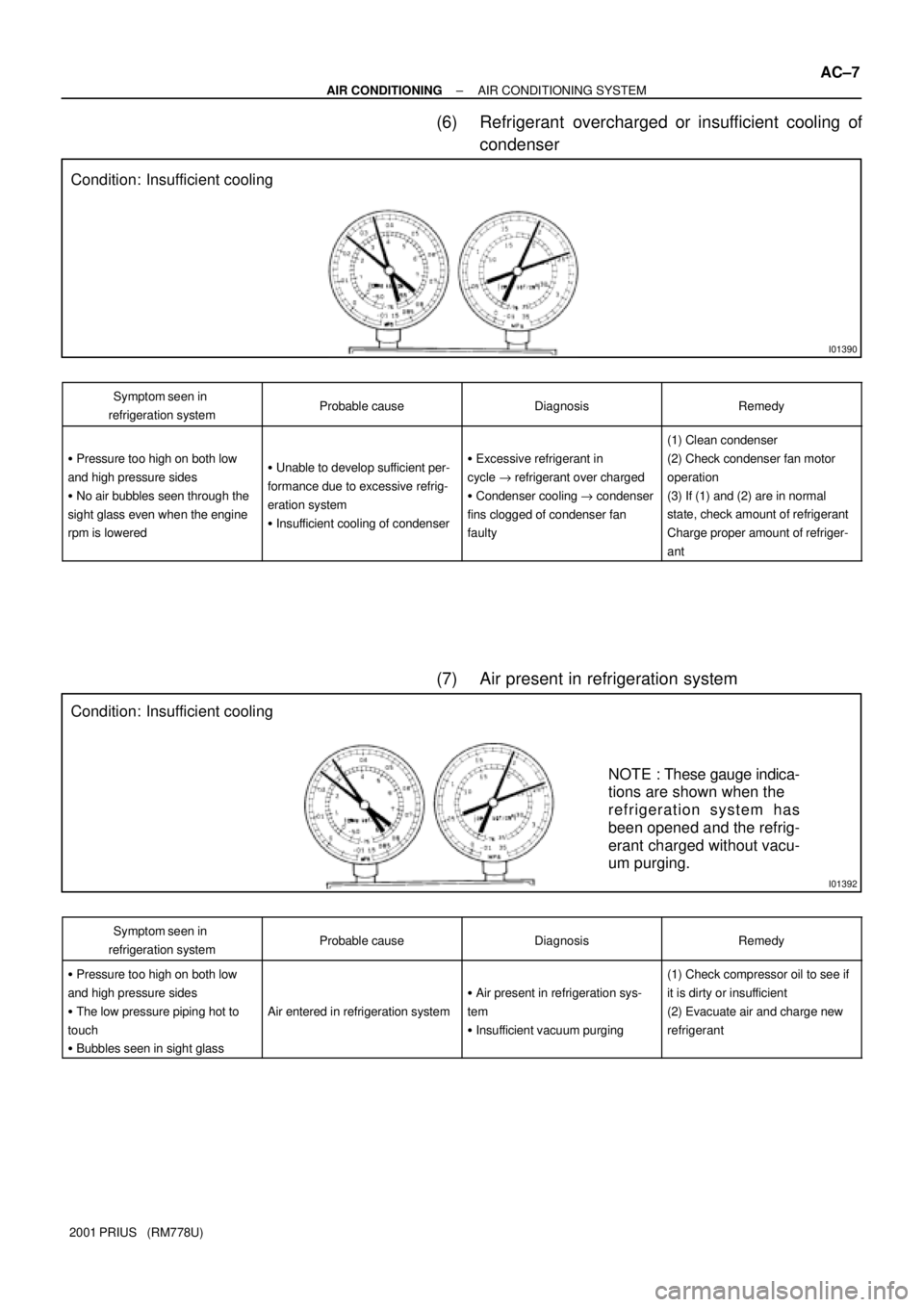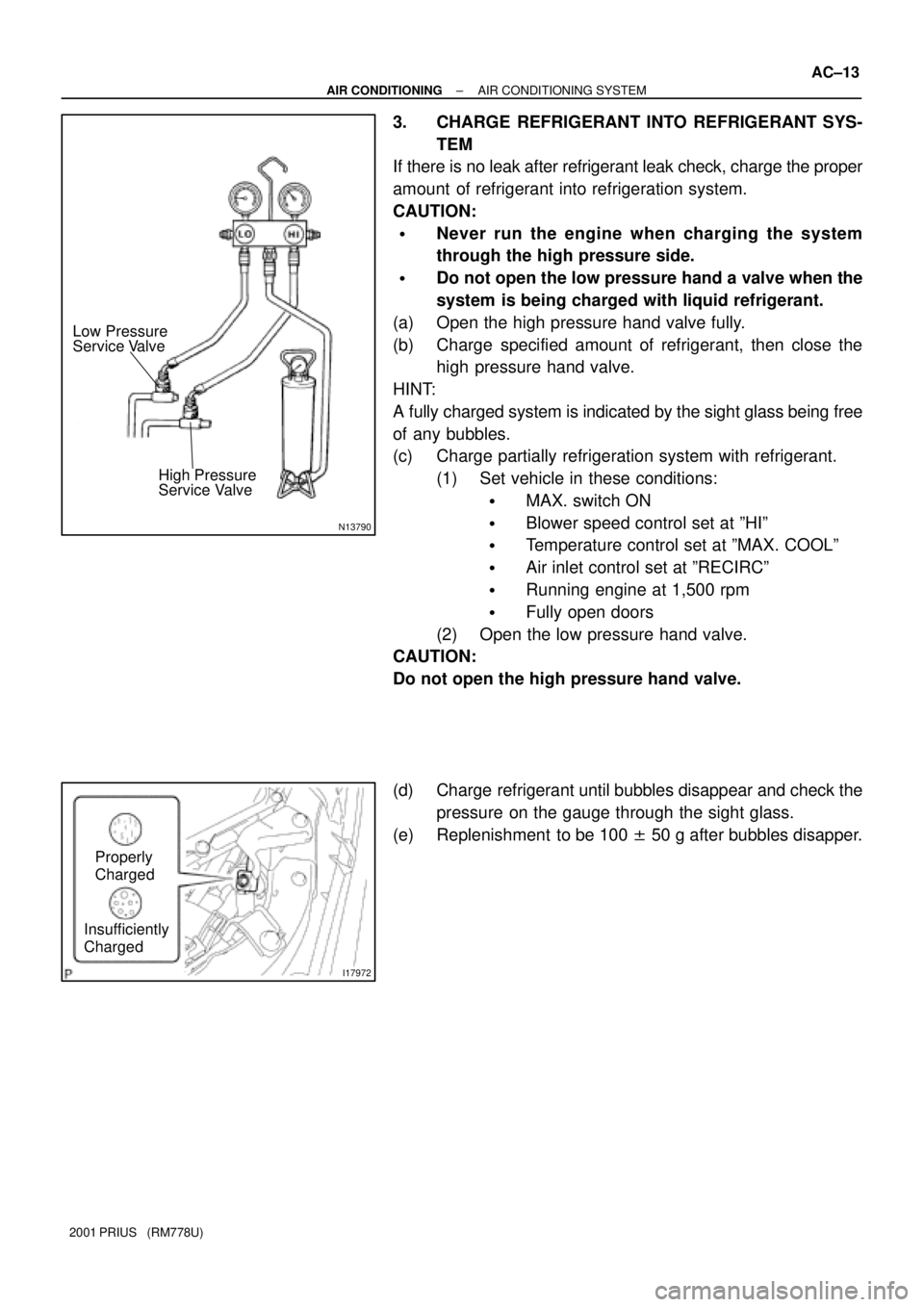Page 1790 of 1943

BE1217
BatteryWarning Light
Ignition
Switch
I11650
BE0044
BatteryWarning Light
Ignition
Switch
Z11183
± BODY ELECTRICALCOMBINATION METER
BE±45
2001 PRIUS (RM778U)
9. INSPECT BRAKE WARNING SYSTEM LIGHT
(a) Disconnect the connector from the brake fluid warning
switch.
(b) Connect terminals of the wire harness side of the level
warning switch connector.
(c) Start the engine, check that the warning light lights up.
If the warning light does not light up, test the bulb or wire har-
ness.
10. INSPECT BRAKE FLUID LEVEL WARNING SWITCH
CONTINUITY
(a) Remove the reservoir tank cap and strainer.
(b) Disconnect the connector.
(c) Check that no continuity exists between terminals with the
switch OFF (float up).
(d) Use syphon, etc. to take fluid out of the reservoir tank.
(e) Check that continuity exists between terminals with the
switch ON (float down).
(f) Pour the fluid back in the reservoir tank.
If operation is not as specified, replace the switch.
11. INSPECT PARKING BRAKE WARNING LIGHT
(a) Disconnect the connector from the parking brake switch.
(b) Ground terminal of the wire harness side connector.
(c) Start the engine, check that the warning light lights up.
If the warning light does not light up, test the bulb or inspect wire
harness.
12. INSPECT PARKING BRAKE SWITCH CONTINUITY
(a) Check that continuity exists between terminal and switch
body with the switch ON (switch pin released).
(b) Check that no continuity exists between terminal and
switch body with the switch OFF (switch pin pushed in).
If operation is not as specified, replace the switch or inspect
ground point.
Page 1837 of 1943

BE1W9±01
BE±104
± BODY ELECTRICALHYBRID VEHICLE IMMOBILISER SYSTEM
1771 Author�: Date�:
2001 PRIUS (RM778U)
HYBRID VEHICLE IMMOBILISER SYSTEM
REGISTRATION PROCEDURE
1. THE COMMUNICATION BETWEEN THE HYBRID VEHICLE CONTROL ECU AND THE TRANS-
PONDER KEY ECU IS AS FOLLOWS
(a) When the ignition is turned ON, the transponder key ECU checks if the key is pre±registered or not
and sends the check result to the hybrid vehicle control ECU.
(b) When the hybrid vehicle control ECU confirms that the key is pre±registered, it transmits its own ID
(random numbers) to the transponder key ECU.
(c) Receiving the ID, the transponder key ECU calculates internally and sends the calculated result back
to the hybrid vehicle control ECU.
(d) The hybrid vehicle control ECU rechecks the calculation inside the ECU.
When the calculation result corresponds to its own ID, this enables the engine to start.
2. PREASE DO THE FOLLOWING PROCEDURES WHEN YOU EXCHANGE TRANSPONDER KEY
ECU
HINT:
When replacing the transponder key ECU or hybrid vehicle control ECU, start the engine after leaving it for
more than 30 minutes with the ignition switch ON position.
(a) (Case 1):
Replace the transponder key ECU. "Register the new transponder key codes. "Leave more than
30 minutes with the ignition switch ON. "Start the engine.
(b) (Case 2):
Replace the hybrid vehicle control ECU. "Leave more than 30 minutes with the ignition switch ON.
"Start the engine.
(c) (Case 3):
Replace the transponder key ECU and hybrid vehicle control ECU. "Register the new transponder
key codes. "Start the engine.
3. IF ALL KEYS ARE LOST, OBSERVE THE FOLLOWING
(a) Purchase a new transponder key ECU and a new key.
(b) Replace the transponder key ECU with new one.
(c) Insert a new key into the key cylinder, turn the ignition switch ON and leave it as it is for 30 min.
4. SETTING HYBRID VEHICLE IMMOBILISER SYSTEM
(a) Removing a key from the key cylinder sets hybrid vehicle immobiliser system.
(b) When 20 sec is elapsed after the key is turned from ignition switch ON to ACC or LOCK, the hybrid
vehicle immobiliser is set.
5. UNSETTING HYBRID VEHICLE IMMOBILISER SYSTEM
Insert a key into the key cylinder
(Under this condition, transponder key ECU starts communication with the transponder chip built in the key.
When the ID code in the chip coincides with that registered in ECU consecutively 2 times, the hybrid vehicle
immobiliser system is reset).
Page 1845 of 1943
The engine dose not starting?
Is DTC code 21, 22 output?
� Wire harness faulty (Open circuit)
� Transponder key EUC faulty
NoYe s
Is DTC code 31, 32, 33
output?
No
� Check the wire harness and connector between the
hybrid vehicle control ECU and transponder key ECU.
� Check that wire harness and connector between the
engine ECU and transponder key ECU.
DTC 31 Go to (a)
DTC 32 Go to (b)
DTC33 Go to (C)
Register the transponder key again.If it cannot be registered (due to chip failure), replace the key.
Hybrid vehicle immobiliser system is normal.
NG
OK
± BODY ELECTRICALHYBRID VEHICLE IMMOBILISER SYSTEM
BE±113
2001 PRIUS (RM778U)
4. TROUBLE SHOOTING
�If code 31 is output, troubleshoot according to this flow chart.
Page 1846 of 1943
Can the engine be started with any other key of the vehicle?
YESNO
Does continuity exist in the coil in continuity test?
Replace the AMP and check if it starts?
Does continuity exist in W/H in continuity test?Replace the coil (Coil broken)Replace the key (Chip failure)
Replace the AMP (AMP failure)
Replace the Transponder key ECU
(Transponder key ECU failure)
Repair or replace the wire harness or the connector.
YES NO YES
NO
YES
NO
Can the engine be started with any other key of the vehicle?
Replace the AMP and check if it starts?
Replace the key (Chip failure)
Replace the Transponder key ECU
(Transponder key ECU failure)YES
NO
Replace the AMP (AMP failure)YES
NO BE±114
± BODY ELECTRICALHYBRID VEHICLE IMMOBILISER SYSTEM
2001 PRIUS (RM778U)
�If code 32 is output, troubleshoot according to this flow chart.
�If code 33 is output, troubleshoot according to this flow chart.
Page 1908 of 1943

AC0YB±04
I17971
ight Glass
± AIR CONDITIONINGAIR CONDITIONING SYSTEM
AC±3
2001 PRIUS (RM778U)
ON±VEHICLE INSPECTION
1. INSPECT REFRIGERANT VOLUME
Observe the sight glass on the liquid tube.
Test conditions:
�MAX. switch ON
�Blower speed control set at ºHIº
�Temperature control set at ºMAX. COOLº
�Running engine at 1,500 rpm
�Fully open the doors
ItemSymptomAmount of refrigerantRemedy
1Bubbles present in sight glassInsufficient*
(1) Check for gas leakage with gas leak de-
tector and repair if necessary
(2) Add refrigerant until bubbles disappear
2No bubbles present in sight glassNone, sufficient or too muchRefer item 3 and 4
3No temperature difference between com-
pressor inlet and outletEmpty or nearly empty
(1) Check for gas leakage with gas leak de-
tector and repair if necessary
(2) Add refrigerant until bubbles disappear
4Temperature between compressor inlet and
outlet is noticeably differentCorrect or too muchRefer to items 5 and 6
5Immediately after air conditioning is turned
off, refrigerant in sight glass stays clearToo much
(1) Discharge refrigerant
(2) Evacuate air and charge proper amount
of purified refrigerant
6When air conditioning is turned off, refriger-
ant foams and then stays clearCorrect±
*: Bubbles in the sight glass with ambient temperatures higher than usual can be considered normal if cooling
is sufficient.
Page 1912 of 1943

I01390
Condition: Insufficient cooling
I01392
Condition: Insufficient cooling
NOTE : These gauge indica-
tions are shown when the
refrigeration system has
been opened and the refrig-
erant charged without vacu-
um purging.
± AIR CONDITIONINGAIR CONDITIONING SYSTEM
AC±7
2001 PRIUS (RM778U)
(6) Refrigerant overcharged or insufficient cooling of
condenser
Symptom seen in
refrigeration systemProbable causeDiagnosisRemedy
� Pressure too high on both low
and high pressure sides
� No air bubbles seen through the
sight glass even when the engine
rpm is lowered� Unable to develop sufficient per-
formance due to excessive refrig-
eration system
� Insufficient cooling of condenser� Excessive refrigerant in
cycle " refrigerant over charged
� Condenser cooling " condenser
fins clogged of condenser fan
faulty
(1) Clean condenser
(2) Check condenser fan motor
operation
(3) If (1) and (2) are in normal
state, check amount of refrigerant
Charge proper amount of refriger-
ant
(7) Air present in refrigeration system
Symptom seen in
refrigeration systemProbable causeDiagnosisRemedy
� Pressure too high on both low
and high pressure sides
� The low pressure piping hot to
touch
� Bubbles seen in sight glass
Air entered in refrigeration system
� Air present in refrigeration sys-
tem
� Insufficient vacuum purging
(1) Check compressor oil to see if
it is dirty or insufficient
(2) Evacuate air and charge new
refrigerant
Page 1915 of 1943
AC±10
± AIR CONDITIONINGAIR CONDITIONING SYSTEM
2001 PRIUS (RM778U)
4. INSPECT IDLE±UP SPEED
(a) Activate inspection mode (See page IN±10).
(b) Inspect idle±up speed when the these conditions are es-
tablished.
Test conditions:
�Idle speed set correctly.
�Steering wheel straight ahead
�Blower speed control dial at HI
�A/C switch ON
Magnetic clutch conditionIdle speed
Magnetic clutch not engaged1,000 ±50 rpm
Magnetic clutch engaged1,000 ±50 rpm
If idle speed is not as specified, check the engine ECU and
throttle body.
Page 1917 of 1943

N13790
Low Pressure
Service Valve
High Pressure
Service Valve
I17972
Properly
Charged
Insufficiently
Charged
± AIR CONDITIONINGAIR CONDITIONING SYSTEM
AC±13
2001 PRIUS (RM778U)
3. CHARGE REFRIGERANT INTO REFRIGERANT SYS-
TEM
If there is no leak after refrigerant leak check, charge the proper
amount of refrigerant into refrigeration system.
CAUTION:
�Never run the engine when charging the system
through the high pressure side.
�Do not open the low pressure hand a valve when the
system is being charged with liquid refrigerant.
(a) Open the high pressure hand valve fully.
(b) Charge specified amount of refrigerant, then close the
high pressure hand valve.
HINT:
A fully charged system is indicated by the sight glass being free
of any bubbles.
(c) Charge partially refrigeration system with refrigerant.
(1) Set vehicle in these conditions:
�MAX. switch ON
�Blower speed control set at ºHIº
�Temperature control set at ºMAX. COOLº
�Air inlet control set at ºRECIRCº
�Running engine at 1,500 rpm
�Fully open doors
(2) Open the low pressure hand valve.
CAUTION:
Do not open the high pressure hand valve.
(d) Charge refrigerant until bubbles disappear and check the
pressure on the gauge through the sight glass.
(e) Replenishment to be 100 ± 50 g after bubbles disapper.